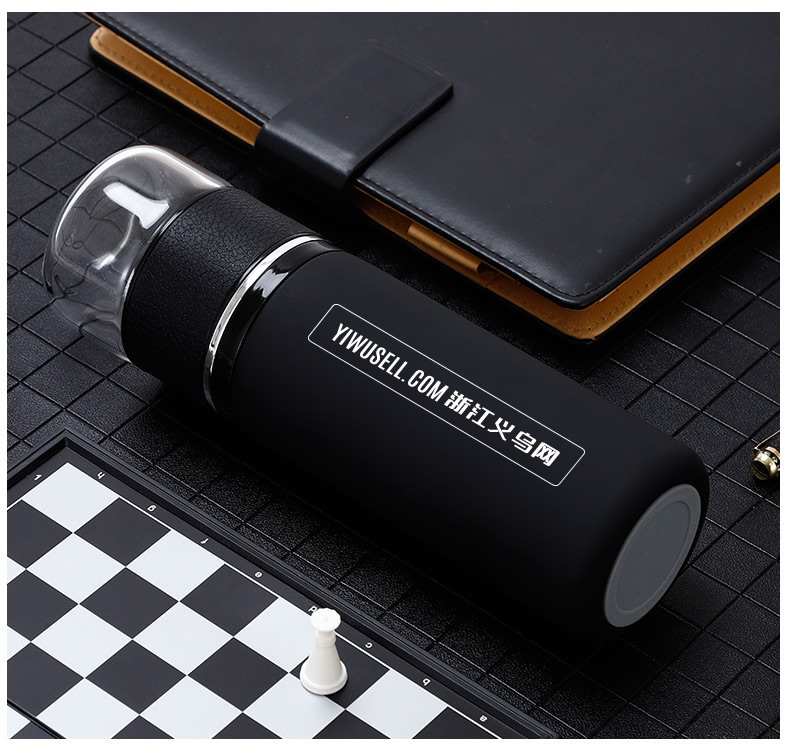Vacuum flasks, also known as thermos flasks, have become an indispensable tool for keeping food and drinks hot or cold for extended periods of time. These containers are designed to maintain the temperature of the contents by minimizing heat transfer between the inside and outside of the flask. The science behind vacuum flasks is fascinating, and their applications are numerous.
The basic principle behind the vacuum flask is the concept of insulation. Heat is transferred through conduction, convection, and radiation. Conduction occurs when heat is transferred through a solid material, such as the walls of a container. Convection occurs when heat is transferred through a fluid, such as air or water. Radiation occurs when heat is transferred through electromagnetic waves, such as light or infrared radiation.
Vacuum flasks are designed to minimize all three types of heat transfer. The flask consists of two layers of glass or plastic separated by a vacuum. The inner layer contains the contents of the flask, while the outer layer acts as an insulator, preventing heat from entering or leaving the flask. The vacuum between the two layers of glass or plastic also prevents convection from occurring.
In addition to the vacuum insulation, many vacuum flasks have a reflective coating on the inner surface of the outer layer. This coating reflects radiation back into the flask, further reducing heat transfer. Some flasks also have a copper or aluminum layer between the two layers of glass or plastic. These metals are good conductors of heat and help to distribute heat evenly throughout the flask.
Vacuum flasks can be used to keep a variety of foods and drinks hot or cold. They are commonly used for coffee, tea, soup, and other hot beverages. They are also used for cold drinks such as water, juice, and soda. Vacuum flasks can even be used to keep ice cream cold for several hours.
One of the key benefits of using a vacuum flask is that it can help to reduce waste. Many people use disposable cups or bottles for their hot or cold drinks, which can create a lot of unnecessary waste. By using a vacuum flask, you can eliminate the need for disposable cups and bottles, reducing your environmental impact.
Vacuum flasks are also great for outdoor activities such as camping, hiking, and picnics. They are lightweight and easy to carry, making them ideal for taking on the go. They can keep your food and drinks at the desired temperature for hours, allowing you to enjoy your outdoor activities without having to worry about your food and drinks getting too hot or too cold.
In conclusion, vacuum flasks are an essential tool for anyone who wants to keep their food and drinks hot or cold for extended periods of time. They work by minimizing heat transfer through insulation and reflective coatings. They are versatile and can be used for a variety of foods and drinks. They are also eco-friendly and can help to reduce waste. Whether you’re on a camping trip or just want to enjoy a hot cup of coffee at your desk, a vacuum flask is a must-have item.
A vacuum flask, also known as a thermos, is a container designed to keep liquids hot or cold for extended periods of time. It is made up of two walls with a vacuum between them, which creates an insulating effect that prevents heat transfer.
The history of the vacuum flask dates back to the late 19th century, when Scottish physicist Sir James Dewar invented the first version. However, it wasn’t until the 20th century that the vacuum flask became widely popular and was used for a variety of purposes, including camping, picnics, and everyday use.
The design of a vacuum flask is simple yet effective. The outer wall is made of metal or plastic, while the inner wall is made of glass or stainless steel. The two walls are separated by a vacuum, which is created by removing the air between them. This creates a barrier that prevents heat transfer, keeping the contents of the flask hot or cold for hours.
One of the key benefits of a vacuum flask is its ability to maintain temperature. Whether you’re looking to keep your coffee hot on a long commute or your water cold on a hot summer day, a vacuum flask can help. The insulating effect created by the vacuum ensures that the temperature of the contents remains constant, regardless of the temperature outside.
Another benefit of a vacuum flask is its portability. Many models are small enough to fit in a backpack or purse, making them perfect for on-the-go use. Additionally, many models come with built-in cups or mugs, making it easy to enjoy your favorite hot or cold beverage wherever you go.
When it comes to choosing a vacuum flask, there are a few things to consider. First and foremost, you’ll want to consider the size. Depending on your needs, you may want a smaller flask for personal use or a larger one for sharing with friends and family. Additionally, you’ll want to consider the material of the flask. Stainless steel is durable and easy to clean, while glass provides a more traditional look and feel.
In conclusion, a vacuum flask is a simple yet effective way to keep your favorite beverages hot or cold for extended periods of time. With its insulating properties and portability, it’s no wonder that it has become a popular choice for people around the world. So whether you’re heading out on a camping trip or simply need to keep your coffee warm during your morning commute, a vacuum flask is a must-have accessory.
Yiwu News
- How to buy an electric mobility device for an elderly person
- How to buy elderly electric mobility?
- All the photovoltaic modules we use come from China
- A keychain is a small and portable item used to hold keys together
- kitchen products section is one of the most popular in Yiwu International Trade City
- Cartoon keychains are often made of plastic or rubber
- Solar light is a technology that harnesses the power of the sun to provide light
- Yiwu Market is the largest small commodity wholesale market in the world and attracts buyers from all over the globe.
- Yiwu City is a city located in the Zhejiang Province of China
- Yiwu International Trade City is a famous wholesale market located in Yiwu, China
- Yiwu International Trade City is one of the largest wholesale markets in the world
- What’s packing cubes?how to buy packing cubes
- What’s hanging photo frame?
- How to choose a hairpin?
- What’s Jewelry?
- What’s kichen items?
- Chenille carpet TPR Bottom
- Welcome to yiwu international trade city
- About the products of Yiwu sell official website
- Yoga Clothes for women,T Shirts for women
Vacuum flasks, also known as thermos flasks, have been around for over a century. Originally designed to keep liquids hot or cold, they have evolved into versatile coldkeeping containers that are used in a variety of settings. In this article, we will explore the history and science behind vacuum flasks, as well as their modern-day applications.
The history of vacuum flasks can be traced back to the late 19th century, when Scottish scientist Sir James Dewar invented the first vacuum flask. Dewar was studying low-temperature physics and needed a container that could keep his liquid gases cold for extended periods of time. He discovered that by creating a vacuum between two layers of glass, he could significantly reduce heat transfer and keep his liquids cold for much longer.
Dewar’s invention was quickly adopted by the scientific community and became known as the Dewar flask. However, it wasn’t until 1904 that the first commercial vacuum flask was introduced by German company Thermos GmbH. The company’s founder, Reinhold Burger, had acquired the rights to Dewar’s patent and began producing vacuum flasks for household use.
The basic design of a vacuum flask consists of two layers of glass separated by a vacuum. The inner layer is coated with a reflective material, such as silver or aluminum, to prevent heat transfer by radiation. The space between the two layers is evacuated to create a vacuum, which significantly reduces heat transfer by conduction and convection.
When a hot or cold liquid is poured into a vacuum flask, the vacuum prevents heat from escaping or entering the flask. This means that hot liquids stay hot and cold liquids stay cold for extended periods of time. In fact, a well-made vacuum flask can keep liquids hot or cold for up to 24 hours.
Vacuum flasks are commonly used for outdoor activities such as camping and hiking, as well as in the food and beverage industry for transporting and storing hot and cold drinks. They are also popular in medical settings for storing vaccines and other temperature-sensitive medications.
In recent years, vacuum flasks have become more advanced and specialized. Some models feature built-in temperature gauges and digital displays to monitor the temperature of the liquid inside. Others are designed specifically for carbonated beverages, with special seals and valves to prevent carbonation from escaping.
In conclusion, vacuum flasks have come a long way since their invention over a century ago. They have become a staple in many industries and are used by millions of people around the world. Whether you’re enjoying a hot cup of coffee on a camping trip or transporting vaccines across the globe, vacuum flasks are an essential tool for keeping liquids at their desired temperature.
A vacuum flask, also known as a thermos flask, is a container designed to keep liquids at a constant temperature for an extended period. The flask consists of two layers of glass or plastic separated by a vacuum. The vacuum layer reduces heat transfer by conduction and convection, while the reflective surface of the inner layer reduces heat transfer by radiation.
The history of the vacuum flask dates back to the late 19th century when Sir James Dewar, a Scottish physicist and chemist, invented it. Dewar was interested in the study of low-temperature phenomena and was looking for a way to store liquid gases at low temperatures. He developed a double-walled container with a vacuum layer between the walls to reduce heat transfer.
Today, vacuum flasks are used for a variety of purposes. They are commonly used to keep hot beverages hot and cold beverages cold. They are also used to store and transport food, medicine, and chemicals that require a constant temperature.
Vacuum flasks come in different sizes and shapes. The most common shape is cylindrical, but they can also be rectangular or square. They are made from a variety of materials, including glass, stainless steel, and plastic. Glass vacuum flasks are fragile but offer better insulation than plastic flasks. Stainless steel flasks are durable and offer excellent insulation.
When using a vacuum flask, it is essential to preheat or precool the flask before adding the liquid. This step helps to maintain the temperature of the liquid for an extended period. It is also important to fill the flask to its maximum capacity to reduce heat transfer.
Cleaning a vacuum flask is essential to maintain its performance. Most vacuum flasks come with cleaning instructions that should be followed carefully. It is recommended to clean the flask after each use to prevent bacteria growth and odors.
In conclusion, a vacuum flask is an essential item for anyone who wants to keep their beverages or food at a constant temperature for an extended period. With proper use and maintenance, a vacuum flask can provide years of reliable service.


